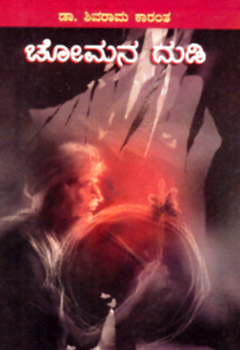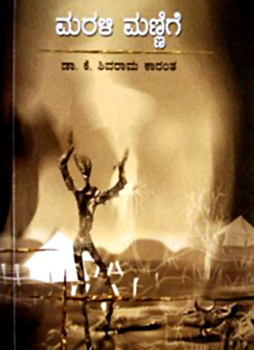 Novels in modern Kannada literature are many in number. The first social novel, Indirabayi, was written by Gulvadi Venkatarav in 1899, and this was followed by Bolara Baburav`s Vagdevi (1905). Baburav depicts Vagdevi, a married woman, betraying her husband by having relations with the head of a Hindu religious organization, thereby showing the decadence of both family and the traditional religious organization. Madiddunno Maraya (1916), the first major novel in Kannada, depicts life in a village near Mysore, the then-capital of the Mysore province. In a traditional Indian society, the temple, the king, the guru, and the Brahmin family are seen as the "protectors" of communal values. But in this novel, the temple is occupied by thieves, the guru has become a bully, the Brahmin family has lost its moral right due to internal quarrels, and the king is unable to establish order in the society because of his inability to see corruption among his lieutenants. The novel gives graphic pictures of decadence of all the traditional ways of living. The king, the Brahmin, and the daughter-in-law, who shape their lives according to traditional values, are unaware that these values are challenged by the changes taking place around them. Ultimately, order is established. But the ending is ambiguous: the question of who establishes order, the British or the king of Mysore, remains unanswered.
Novels in modern Kannada literature are many in number. The first social novel, Indirabayi, was written by Gulvadi Venkatarav in 1899, and this was followed by Bolara Baburav`s Vagdevi (1905). Baburav depicts Vagdevi, a married woman, betraying her husband by having relations with the head of a Hindu religious organization, thereby showing the decadence of both family and the traditional religious organization. Madiddunno Maraya (1916), the first major novel in Kannada, depicts life in a village near Mysore, the then-capital of the Mysore province. In a traditional Indian society, the temple, the king, the guru, and the Brahmin family are seen as the "protectors" of communal values. But in this novel, the temple is occupied by thieves, the guru has become a bully, the Brahmin family has lost its moral right due to internal quarrels, and the king is unable to establish order in the society because of his inability to see corruption among his lieutenants. The novel gives graphic pictures of decadence of all the traditional ways of living. The king, the Brahmin, and the daughter-in-law, who shape their lives according to traditional values, are unaware that these values are challenged by the changes taking place around them. Ultimately, order is established. But the ending is ambiguous: the question of who establishes order, the British or the king of Mysore, remains unanswered.
Masti Venkatesha Iyengar`s works include translations of some of the major plays of Shakespeare, critical works on the Mahabharata and the Ramayana, poetry, and plays. He was also the chairman of Kannada Sahitya Parishat, a democratic literary body founded by B. M. Srikantia and others in 1915, and the editor of an influential little magazine. Masti was also responsible for publishing the first works of Bendre and Kuvempu. Masti`s writings show remarkable insight into the lives of the ordinary people in the villages. His short story, "Mosarina Marigamma," depicts the quarrels in a joint family in a village. Mangamma, a curd-seller, is insulted by her daughter-in-law and decides to live separately. But the village is so traditional in its values and lifestyles that she can live peacefully only in a traditional way. Any attempt to upset this system leads to strained personal relationships. His "Kalmadiya Kona," another short story, is about the relationships among people, society, and animal. Muniya, who has raised a male buffalo, is forced to sacrifice it to Man, a goddess. By portraying Muniya`s efforts to save the buffalo and the people`s insistence on sacrifice, Masti is drawing our attention to the stronghold of superstitions on the minds of the people. Any attempt to bring about a change in the traditional lifestyle leads to its continuation with greater vigor.
His "Chattekara Tayi" depicts the lives of Anglo-Indians. "Masumatti" and "Rariganahalliya Rama" are about the reactions of Europeans to Indian culture and civilization. Both stories explore the ways the Indian past can become real in the present. In "Masumatti," Indian antiques are used for commercial purposes by all European characters except Emily, who is able to link her personal life to the Indian past. "Rariganahalliya Rama" narrates the ways a persuasive Britisher makes the lost past real to the superstitious, but courteous, Indian villagers. All three stories are important because they show different aspects of the encounters between the East and the West. His novel Chikavirarajendra (1956) depicts the process of colonization of Kodagu, a small province in Karnataka, by the British. It is colonized because of the cunning of the British and the decadence of Chikavirarajendra, the king of Kodagu. Masti powerfully portrays how the goodness and the traditional values of these tribal people turn out to be their weaknesses when it comes to the question of encountering an alien culture and military power. As Masti suggests in the novel, this could be the story of any kingdom in India when it encountered the British in the nineteenth century.
 Kakana Kote, one of the plays by Masti, is also about the encounter between two cultures. Kakana Kote, a tribal settlement, is threatened by the king`s men, who demand an illegal levy. The tribal settlement can be protected if the headman of the tribes requests the king of Mysore, whose life he once saved, for protection. But then the cultural and political autonomy of the tribe will be destroyed. The headman is ultimately forced to ask for protection. As a result, the tribal settlement comes under the king`s jurisdiction and thus loses its identity. The play is a profound study of the encounter between tribal and urban cultures. In minute details, Masti brings out the psychology of the tribal and urban people when they encounter each other. It is also a study of the colonization of a tribal settlement by the city dwellers. Masti suggests that the change was inevitable. The king`s men who were demanding illegal levy would have continued to interfere in tribal culture and would have, thus, changed it. The headman, by requesting the king for protection, has only given official sanction to the change.
Kakana Kote, one of the plays by Masti, is also about the encounter between two cultures. Kakana Kote, a tribal settlement, is threatened by the king`s men, who demand an illegal levy. The tribal settlement can be protected if the headman of the tribes requests the king of Mysore, whose life he once saved, for protection. But then the cultural and political autonomy of the tribe will be destroyed. The headman is ultimately forced to ask for protection. As a result, the tribal settlement comes under the king`s jurisdiction and thus loses its identity. The play is a profound study of the encounter between tribal and urban cultures. In minute details, Masti brings out the psychology of the tribal and urban people when they encounter each other. It is also a study of the colonization of a tribal settlement by the city dwellers. Masti suggests that the change was inevitable. The king`s men who were demanding illegal levy would have continued to interfere in tribal culture and would have, thus, changed it. The headman, by requesting the king for protection, has only given official sanction to the change.
Kota Shivarama Karanth (1902) is another major literary figure of the twentieth century. He gave up a college education to participate in the freedom struggle in the 1920s. He has experimented in the areas of education, painting, and music. His experiments in Yakshagana, folk dance drama, have won him worldwide acclaim. He has also been active in ecological movements. He has written plays, children`s literature, essays, and criticism. But his major contribution is in fiction.
Chomana Dudi, Sarasammana Samddhi, Marali Mannige, and Maimanagala Suliyalli, some of his major novels, depict various aspects of life in rural Karnataka. Chomana Dudi narrates an untouchable`s attempt to become a farmer. In traditional Indian society, an untouchable is forbidden to till the land. Choma fails in his attempts. But in the course of narrating Choma`s attempts to become a farmer, Karanth depicts the changes that were taking place in the lives of the untouchables in the twentieth century. He also portrays the ruthlessness of the upper-caste people determined to retain caste distinctions. Karanth`s greatness lies in showing how the psychology of both the upper- and lower-caste people is determined by caste considerations. Marali Mannige is a story of three generations. Rama Aithala is a traditional Brahmin fascinated by English education. He wants his son to be a lawyer and decides to give him an English education. But his son, Laccha, is alienated from his family, relatives, and the native land due to the negative influence of the West. Rama, grandson of Rama Aithala, is able to use the Western influence creatively to renew himself and the tradition-bound society in which he lives.
Maimanagala Suliyalli is also a story of three generations. The woman of the first generation is a devadasi, God`s bride. She is supposed to entertain chosen men in the name of God. She is famous for her integrity and music. But Karanth knows that she belongs to a dying culture. Her daughter and granddaughter show the negative and positive influences of the Western culture, respectively. The novel also examines the philosophical problem of the unification of body and mind. All the characters satisfy either their mind or their body, not both. As a result, they always remain unhappy. Karanth`s attitude toward change is ambiguous. He thinks that the change brought about by the influence of the West or the East becomes positive only when one links oneself to one`s people and their culture. It becomes destructive when it takes one away from one`s roots, a result that, for him, seems to be one of the radical problems of colonial India.
Thus the novels of the Kannada writers showcase a number of different forces and changes sweeping across society.



















